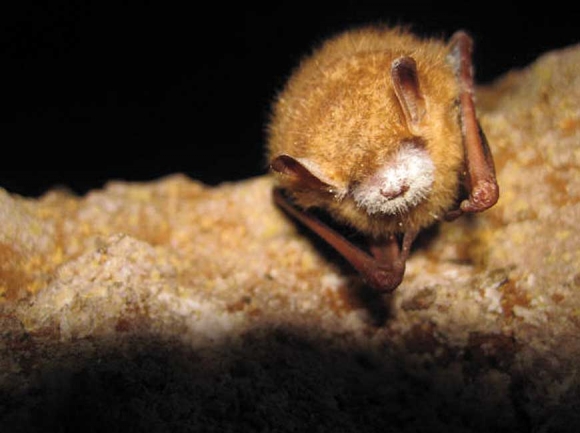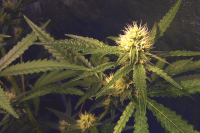Deadly bat disease spreads to more N.C. counties
 An infected bat displays the tell-tale white fungus associated with white nose syndrome. NPS photo
An infected bat displays the tell-tale white fungus associated with white nose syndrome. NPS photo
There’s more bad news for bats following winter surveys that detected the deadly-to-bats white nose syndrome in four new counties — Madison, Montgomery, Rowan and Gaston.
WNS has killed millions of bats in the eastern U.S. since it was first detected in New York 13 years ago, and thousands of bats in North Carolina since it was found there in 2011.
Discouragingly, the fungus appears to be taking an eastward trajectory and spreading to more Piedmont counties. Until 2015, WNS had been found only in bats hibernating in mountain counties, presumably because the fungus that causes the disease can survive only in the cooler temperatures found in mines and caves, most of which occur in the mountains. With the four new counties where WNS’ presence was confirmed last winter, the number of counties where the fungus is found has reached 16.
Bats at the Madison County site were the only ones that showed visible signs of the fungal growth consistent with WNS, which is the telltale sign of WNS infection. At the other three sites, bats tested positive, although they did not show the characteristic white fungus that gives the disease its name. While the survey results were disappointing, Katherine Etchison, bat biologist for the N.C. Wildlife Resources Commission, is somewhat encouraged by the fact that biologists saw no signs of fungal growth at any Piedmont or Coastal Plain site, even the ones that tested positive.
“The fact we did not see fungal growth, which is the typical giveaway of a WNS infection, could mean that other factors that contribute to WNS infection are not ideal,” said Etchison. “The Piedmont winters are shorter and warmer than in the mountains where WNS has been devastating, and Piedmont bats are able to arouse and feed on warm winter nights when insects are active.”
Mortality from the disease usually occurs when bats repeatedly expend energy to clean the fungus off themselves during winter in areas of no insect availability, eventually starving to death. If Piedmont bats can feed during winter and replenish fat stores, or if hibernacula are too warm or dry, bats could avoid a WNS infection even if the fungus is present at the site.
Related Items
Despite the WNS detection, bat counts in the Piedmont remain stable, although they are low — ranging from one bat found at one site to 30 bats found at another site. Though these counts are just a fraction of what mountain hibernacula formerly held, the 30-bat site is currently the highest count of hibernating tri-colored bats in any known hibernaculum in the state. Most sites biologists have surveyed in the mountains have had over 90 percent declines in bat populations since WNS was first discovered. Some declines have been as high as 99 percent.
While WNS has a deadly effect on bats, it does not affect people — at least not directly. Indirectly, however, it can have a huge impact on humans by reducing the number of bats in North American ecosystems. The U.S. Geological Service estimates that loss of bats in North America could lead to agricultural losses exceeding $3.7 billion annually.
Biologists will continue their long-term monitoring efforts of bats in North Carolina, concentrating their efforts on caves and mines in the Piedmont and Coastal Plain. But first they need to find hibernacula to survey — a task that is easier said than done, according to Etchison. Landowners who would be willing to have wildlife biologists survey a cave or mine on their property should contact Etchison at This email address is being protected from spambots. You need JavaScript enabled to view it..









